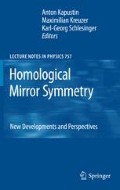Abstract
We review how both derived categories and stacks enter physics. The physical realization of each has many formal similarities. For example, in both the cases, equivalences are realized via renormalization group flow: in the case of derived categories, (boundary) renormalization group flow realizes the mathematical procedure of localization on quasi-isomorphisms and, in the case of stacks, worldsheet renormalization group flow realizes presentation-independence. For both, we outline current technical issues and applications.
Access this chapter
Tax calculation will be finalised at checkout
Purchases are for personal use only
Preview
Unable to display preview. Download preview PDF.
References
C. Weibel, An Introduction to Homological Algebra, Cambridge studies in advanced mathematics 38, Cambridge University Press, 1994.
R. Hartshorne, Residues and Duality, Lecture Notes in Mathematics 20, Springer-Verlag, Berlin, 1966.
R. Thomas, “Derived categories for the working mathematician,” math.AG/0001045.
E. Sharpe, “Lectures on D-branes and sheaves,” lectures given at the twelfth Oporto meeting on “Geometry, topology, and physics,” hep-th/0307245.
A. Vistoli, “Intersection theory on algebraic stacks and on their moduli spaces,” Inv. Math. 97 (1989) 613–670.
T. Gomez, “Algebraic stacks,” Proc. Indian Acad. Sci. Math. Sci. 111 (2001) 1–31, math.AG/9911199.
M. Kontsevich, “Homological algebra of mirror symmetry,” in Proceedings of the International Congress of Mathematicians, pp. 120–139, Birkhäuser, (1995), alg-geom/9411018.
J. Polchinski, “Dirichlet branes and Ramond-Ramond charges,” Phys. Rev. Lett. 75 (1995) 4724–4727, hep-th/9510017.
J. Harvey and G. Moore, “On the algebras of BPS states,” Comm. Math. Phys. 197 (1998) 489–519, hep-th/9609017.
S. Katz and E. Sharpe, “D-branes, open string vertex operators, and Ext groups,” Adv. Theor. Math. Phys. 6 (2003) 979–1030, hep-th/0208104.
S. Katz, T. Pantev, and E. Sharpe, “D-branes, orbifolds, and Ext groups,” Nucl. Phys. B673 (2003) 263–300, hep-th/0212218.
A. Caldararu, S. Katz, and E. Sharpe, “D-branes, B fields, and Ext groups,” Adv. Theor. Math. Phys. 7 (2004) 381–404, hep-th/0302099.
A. Sen, “Tachyon condensation on the brane-antibrane system,” J. High Energy Phys. 08 (1998) 012, hep-th/9805170.
E. Witten, “D-branes and K theory,” J. High Energy Phys. 9812 (1998) 019, hep-th/9810188.
E. Sharpe, “D-branes, derived categories, and Grothendieck groups,” Nucl. Phys. B561 (1999) 433–450, hep-th/9902116.
M. Douglas, “D-branes, categories, and cal n=1 supersymmetry,” J. Math. Phys. 42 (2001) 2818–2843, hep-th/0011017.
T. Bridgeland, “Stability conditions on triangulated categories,” math.Annals of Math. 166 (2007) 317–345.
D. Freed and E. Witten, “Anomalies in string theory with D-branes,” hep-th/9907189.
A. Abouelsaood, C. Callan, C. Nappi, and S. Yost, “Open strings in background gauge fields,” Nucl. Phys. B280 (1987) 599–624.
T. Gomez and E. Sharpe, “D-branes and scheme theory,” hep-th/0008150.
R. Donagi, S. Katz, and E. Sharpe, “Spectra of D-branes with Higgs vevs,” Adv. Theor. Math. Phys. 8 (2005) 813–259, hep-th/0309270.
R. Donagi, L. Ein, and R. Lazarsfeld, “A non-linear deformation of the Hitchin dynamical system,” alg-geom/9504017, a.k.a. “Nilpotent cones and sheaves on K3 surfaces,” pp. 51–61 in Birational Algebraic Geometry, Contemp. Math. 207, Amer. Math. Soc, Providence, Rhode Island, (1997).
P. Aspinwall and A. Lawrence, “Derived categories and zero-brane stability,” J. High Energy Phys. 0108 (2001) 004, hep-th/0104147.
A. Bondal and M. Kapranov, “Enhanced triangulated categories,” Math. USSR Sbornik 70 (1991) 93–107.
C. Lazaroiu, “Generalized complexes and string field theory,” JHEP 0106 (2001) 052, hep-th/0102122.
C. Lazaroiu, “Graded lagrangians, exotic topological D-branes and enhanced triangulated categories,” JHEP 0106 (2001) 064, hep-th/0105063.
E. Diaconescu, “Enhanced D-brane categories from string field theory,” JHEP 0106 (2001) 016, hep-th/0104200.
E. Witten, “Some comments on string dynamics,” contribution to proceedings of Strings ’95, hep-th/9507121.
M. Douglas, B. Greene, and D. Morrison, “Orbifold resolution by D-branes,” Nucl. Phys. B506 (1997) 84–106, hep-th/9704151.
E. Sharpe, “String orbifolds and quotient stacks,” Nucl. Phys. B627 (2002) 445–505, hep-th/0102211.
E. Witten, “Two-dimensional models with (0,2) supersymmetry: perturbative aspects,” hep-th/0504078.
E. Witten, “The N matrix model and gauged WZW models,” Nucl. Phys. B371 (1992) 191–245.
T. Pantev and E. Sharpe, “Notes on gauging noneffective group actions,” hep-th/0502027.
T. Pantev and E. Sharpe, “String compactifications on Calabi-Yau stacks,” Nucl. Phys. B733 (2006) 233–296, hep-th/0502044.
T. Pantev and E. Sharpe, “GLSM’s for gerbes (and other toric stacks),” Adv. Theor. Math. Phys. 10 (2006) 77–121, hep-th/0502053.
S. Hellerman, A. Henriques, T. Pantev, E. Sharpe, and M. Ando, “Cluster decomposition, T-duality, and gerby CFT’s,” Adv. Theor. Math. Phys. 11 (2007) 751–818, hep-th/0606034.
E. Sharpe, “Discrete torsion,” Phys. Rev. D68 (2003) 126003, hep-th/0008154.
E. Sharpe, “Recent developments in discrete torsion,” Phys. Lett. B498 (2001) 104–110, hep-th/0008191.
J. Distler and R. Plesser, private communication.
A. Kapustin, E. Witten, “Electric-magnetic duality and the geometric Langlands program,” hep-th/0604151.
M. Strassler, “Duality, phases, spinors, and monopoles in SO(n) and Spin(n) gauge theories,” hep-th/9709081.
D. Morrison and R. Plesser, “Towards mirror symmetry as duality for two-dimensional abelian gauge theories,” Nucl. Phys. Proc. Suppl. 46 (1996) 177–186, hep-th/9508107.
K. Hori and C. Vafa, “Mirror symmetry,” hep-th/0002222.
L. Borisov, L. Chen, and G. Smith, “The orbifold Chow ring of toric Deligne-Mumford stacks,” math.AG/0309229.
R. Donagi and T. Pantev, “Langlands duality for Hitchin systems,” math.AG/0604617.
D. Abramovich, T. Graber, and A. Vistoli, “Algebraic orbifold quantum products,” math.AG/0112004.
T. Graber and J. Bryan, private communication.
D. Morrison and R. Plesser, “Summing the instantons: quantum cohomology and mirror symmetry in toric varieties,” Nucl. Phys. B440 (1995) 279–354, hep-th/9412236.
R. Karp, “C2/Z_n fractional branes and monodromy,” Comm. Math. Phys. 270 (2007) 163–196, hep-th/0510047.
R. Karp, “On the Cn/Z_m fractional branes,” hep-th/0602165.
C. Herzog and R. Karp, “On the geometry of quiver gauge theories (stacking exceptional collections),” hep-th/0605177.
Author information
Authors and Affiliations
Corresponding author
Rights and permissions
Copyright information
© 2008 Springer-Verlag Berlin Heidelberg
About this chapter
Cite this chapter
Sharpe, E. (2008). Derived Categories and Stacks in Physics. In: Homological Mirror Symmetry. Lecture Notes in Physics, vol 757. Springer, Berlin, Heidelberg. https://doi.org/10.1007/978-3-540-68030-7_8
Download citation
DOI: https://doi.org/10.1007/978-3-540-68030-7_8
Published:
Publisher Name: Springer, Berlin, Heidelberg
Print ISBN: 978-3-540-68029-1
Online ISBN: 978-3-540-68030-7
eBook Packages: Physics and AstronomyPhysics and Astronomy (R0)

